The growing demand for social media communication is changing the nature of marketing and advertising. With consumers able to communicate instantly with companies via a variety of channels, brands need to be more effective in connecting with them. With the rise of social networks, consumers’ attention spans are shorter, and they have more urgent questions than ever before. In fact, 64% of consumers would rather message a company than call or visit their store. As a result, many businesses are not prepared to provide effective customer support via social media. According to a survey by Hootsuite, 71% of organizations don’t plan to invest in this form of customer support.
Digital media has been increasing dramatically since 2004, and the COVID-19 pandemic has only continued this trend. Lockdowns and restrictions on in-person commerce have all contributed to increased usage of social. In a survey by GlobalWebIndex, over 40% of consumers were using social media longer than a year ago and expected to continue this trend in the coming years. Furthermore, nearly a third of consumers had increased their brand interactions on social networks since the pandemic, and this trend is expected to continue in the future.
In the last two years, the growing demand for social media has affected both the business world and the advertising industry. It has also changed how consumers interact with brands. With the COVID-19 pandemic, people are increasingly turning to digital media for information and communication. In the past decade, the COVID-19 pandemic has made people more knowledgeable about international affairs and news. The same trend has changed how businesses market to consumers, and social media workers are required to stay current.
The growing demand for social media has increased the use of digital media. The COVID-19 pandemic has fueled this momentum by limiting in-person commerce. However, some people have expressed ethical concerns about the growing use of social media. The selective behavior of consumers has created echo chambers and encouraged political homophily. This phenomenon has long been known to cause people to group with like-minded people. These groups have proven to be conducive to social identification and conformity.
The growing popularity of social media has impacted businesses in several ways. It is a powerful platform for marketing. Users can find information and communicate with brands on a variety of platforms. The more social platforms a brand is present, the more likely it is to reach the right audience. By having an online presence, businesses can make better decisions. In addition to this, social media allows people to share information with one another and interact with brands.
The use of digital media has been growing steadily in recent years. The COVID-19 pandemic has kept the momentum going. As a result, lockdowns, health-related issues, and restrictions on in-person commerce have all driven people to use social media. As a result, the need for social media workers will continue to increase no matter what the economic situation looks like. They will be in demand for as long as the internet is available.
Despite the fact that the use of social media is a growing trend, it is still a relatively new concept. As a result, it is still in its early stages. The growth of social media has been slowed in recent years due to the COVID-19 pandemic. While it is not entirely clear how this virus affects consumers, the use of digital media is on the rise. In addition, the growing demand for digital communication has shifted the nature of marketing.
Traditionally, businesses have communicated with their customers through traditional advertising and communication mediums. The use of social media has accelerated, but the recent COVID-19 pandemic has been the catalyst for this trend. Despite the recent COVID-19 outbreak, the use of social media has continued to grow. Moreover, the COVID-19 pandemic has led to a massive increase in the number of consumers using social media.




